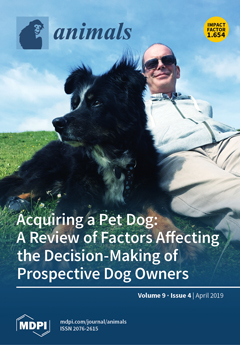The study objective was to determine whether in utero heat stress (IUHS) affects piglet physiology and behavior following common production practices. A total of 12 gilts were confirmed pregnant and allocated to either heat stress (HS;
n = 6) or thermoneutral (TN;
n
[...] Read more.
The study objective was to determine whether in utero heat stress (IUHS) affects piglet physiology and behavior following common production practices. A total of 12 gilts were confirmed pregnant and allocated to either heat stress (HS;
n = 6) or thermoneutral (TN;
n = 6) conditions on day 30–60 of gestation. At weaning (22.5 ± 2.3 days of age), 1 boar and 1 barrow of median weight were selected from each litter and transported for approximately 7 h. Piglets were then blocked into pens (
n = 2/pen) by in utero treatment (IUHS (
n = 12) or in utero thermoneutral (IUTN,
n = 12)) and sexual status (boar (
n = 6/in utero treatment) or barrow (
n = 6/in utero treatment)). Plasma cortisol, non-esterified fatty acids (NEFA), insulin and glucose were evaluated 1 day prior to transport (pre-transport) and immediately after transport (post-transport). Behavioral data were collected on day 1–7 for 60 min at four different time points each day. In utero heat stressed piglets exhibited reduced cortisol concentrations compared to IUTN piglets immediately post-transport (
p = 0.04). Glucose concentrations were not affected by in utero treatment. Insulin concentrations were reduced in IUTN piglets post-transport compared to pre-transport (
p = 0.002), but no differences were detected for IUHS pigs. Non-esterified fatty acids tended to be reduced overall for IUHS vs. IUTN pigs (
p = 0.08). Overall, IUHS piglets performed more drinking behaviors (
p = 0.02) and tended to perform more aggressive behaviors (
p = 0.07) than IUTN piglets in the 7 days post-transport. In summary, there was some evidence for altered physiological and behavioral responses among IUHS piglets compared to IUTN piglets following weaning and transport.
Full article






